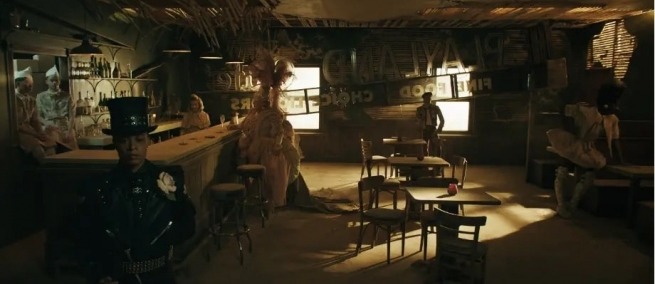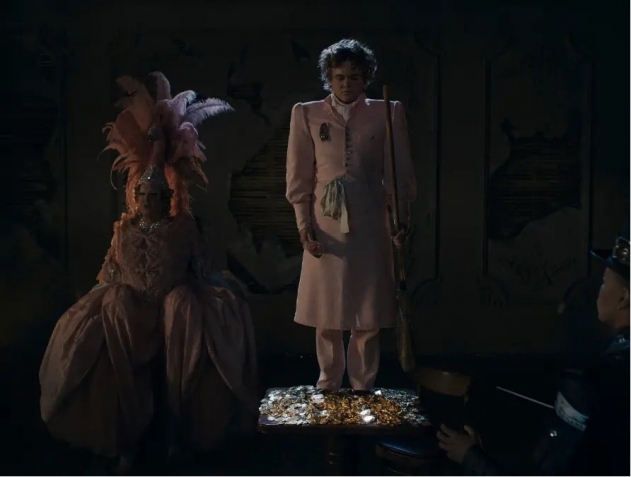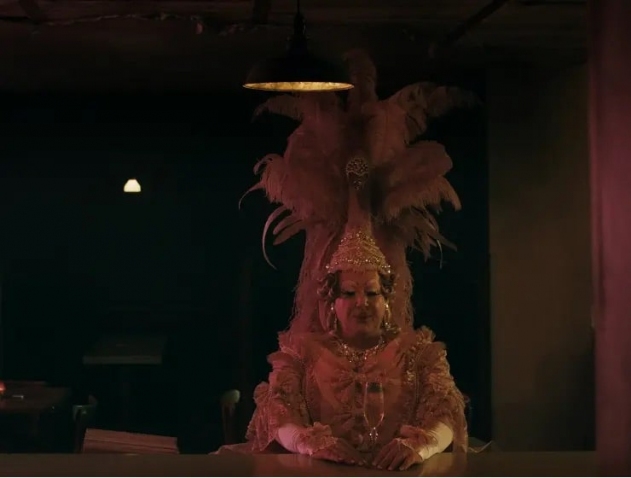
In their transdisciplinary debut feature PLAYLAND, Georden West wonders how the staff and patrons of Playland Cafe, Boston’s oldest gay bar (c. 1937), experienced the bar in its heyday before it was demolished due to urban renewal in 1998. Technology is a throughline in PLAYLAND for its power to encapsulate history. Playland owner Lady and server Sunday (portrayed by drag queen Lady Bunny) keep the bar’s spirit alive through their magic and singing skill set respectively. West goes beyond what has been written about the location—instances of police brutality and changes wrought by gentrification—by using advancements in cinematic technology to imagine the emotional memories of the final outings at this formerly safe space.
West uses archival newsreels and photos in this hybrid scripted/non-scripted film to show how the past informs the universe of the patrons and staff. The film’s fictional characters and use of non-verbal scenes fill the gap left by “archival silence.” In doing so, West honors Playland’s history.
PLAYLAND had its North American premiere at Tribeca 2023 and will make more stops on the festival circuit, including the Provincetown, Frameline, and Outfest International Film Festivals.
SS&F: What was the genesis of PLAYLAND?
Georden West: I started doing archival research at the History Project, New England’s largest independent LGBTQ archive, and I stumbled across the archive of [the drag queen] Sylvia Sidney, who was the queen bitch of Boston. Her exploits regularly end up in the Playland Cafe. I was in Boston and I never heard of the Playland Cafe. I walked over to 21 Essex Street to see what was there. It is a parking garage now. So what would have been Boston’s oldest gay bar I found out is reduced to a parking garage. And for me, that really ignited a fire in regards to cultural heritage. What gets to be preserved in our archives and in history in the built environment? It really opened me up to the potential of there being a project.

Still from PLAYLAND, Courtesy of Tribeca Film Festival
SS&F: I previously attended a panel you participated in last March where you spoke about the “archival silence.” How do you utilize the archive’s silence in the film?
GW: When we’re talking about 20th-century gay history, there is a lack of documentation, especially in the interiors of these brick-and-mortar spaces, out of self-protection, out of the series of sociopolitical pressures that were happening at the time. There were a ton of interior photographs of this space. You didn’t always want your photo taken in the gay bar, as it would compromise your exterior life. I think archival silence also speaks to what a city and what history tries to erase or forget. It's the queer undesirables, in a variety of senses of race and gender, that get erased. It took a lot of innovation to imagine what wasn't there and speak to those gaps. We tried to really capture the uncanniness of what it means to be between. So I think the speakingness is something that I did want to highlight. I didn't want to create any new additions to the archive; I wanted to showcase what was there and speak to what wasn't. So the film largely relies on nonverbal gestures and communications between the characters to allow the oral histories that do exist and have been recorded to really take on the role of dialogue.
SS&F: You mentioned that there were limited interior photos. What were the point(s) of reference in the film’s visuals?
GW: We did have one series of photographs from a holiday in the 1950s, which is just one night. And that's all the archives had in regards to interior photos. But we were also lucky to have the archives of Sylvia Sidney, and the archives of lifelong bartender Jim McGrath. We drew on the histories of numerous gay bars. It took an amalgamation of different histories to rebuild the robust interactions that would happen in that space, specifically between people working within typical economies. In regards to architecting the interior, we wanted to take it and live within that uncanny space of the gay bar as an operatic space. When you walk into a gay bar, music plays such a huge role. Whether it's karaoke or lip sync, you feel like your body is accompanying a set score. We worked with an opera stage designer to give the bar that highbrow-meets-lowbrow aesthetic that is such a huge, predominant feature of the film. That was important to us, to really play in the imaginary space of what the silence is suggesting, that takes you to a place we weren't necessarily representing the reality of the interior, but staying within a fundamental mood that the archives suggested.

Still from PLAYLAND, Courtesy of Tribeca Film Festival
SS&F: How does music travel between the film's grounded reality and metaphysical worlds?
GW: I got really lucky to work with a composer who was ready to test those limits with me. I wouldn’t call Aaron [Michael Smith] a musician, but he's a polymath. He speaks the language of art and speaks the language of history. We toed the line between what is accompaniment, what is sound design, and played within that space of making those things inseparable. I was very determined that the whole space sound like a black hole. It would be a void that contains infinite possibilities, but nothing at all. Then when we heard the NASA release of the black hole sound, that sort of Sonic sphere it felt very similar to what we were able to conjure. I think I got lucky in working with fellow artists who understood what it meant not to pursue a temporal environment, sonically but to embrace an all-encompassing approach to the sonic elements.
SS&F: The film incorporates several histories, not solely of Playland Cafe, but also cinema. How did you play with the technological advancement of cinema and existing materials?
GW: The role of technology played sonically within the bars present [in the film]. I think the emergence of the jukebox in the bar has a lot of symbolic meaning. Throughout this film, we really do explore the social dimension of objects, and what they mean for this specific society of back-of-house staff and performers who occupied the bar. Working with Jo Jo [Lam, the film’s cinematographer] to manifest the look, we were really interested in something that felt contemporary, but also explored a liminal space in regards to the cinematography. I was worried that using 16mm would evoke nostalgia meeting nostalgia. They cancel each other out and become their own dialectic. Because so much of the film is rife with queer nostalgia, using a digital format to capture that elevated what was on-screen, instead of leveling it with something that would have felt like artifice. I think the artifice of the whole film is so omnipresent, that our job was to play there and highlight when it was present.
SS&F: How do you see the role of technology's advancement in queer communities?
GW: I think technology in queer communities and hookup culture in cruising has been blamed for the disappearance of these brick-and-mortar spaces. I think that is a complete misunderstanding. It's a way for governments to sidestep the roles that they played in erasing subcultures. I think Grindr is just a new avenue of meeting people, of course, but the queer brick-and-mortar gathering space is still historically important. Grindr didn't kill the gay bar. Urban renewal did. Gentrification did. I think any sort of digital experience augments your physical reality and brings people who seemingly have disparate lives together. I think these emergent technologies gave people an opportunity to network where there otherwise were no opportunities to network. But specifically Playland was the subject of huge pressure from the Boston Redevelopment Authority. Government intervention in urban renewal efforts is historically the thing that has caused these spaces to close. I'm team Grindr and team gay bar.
♦
TOPICS